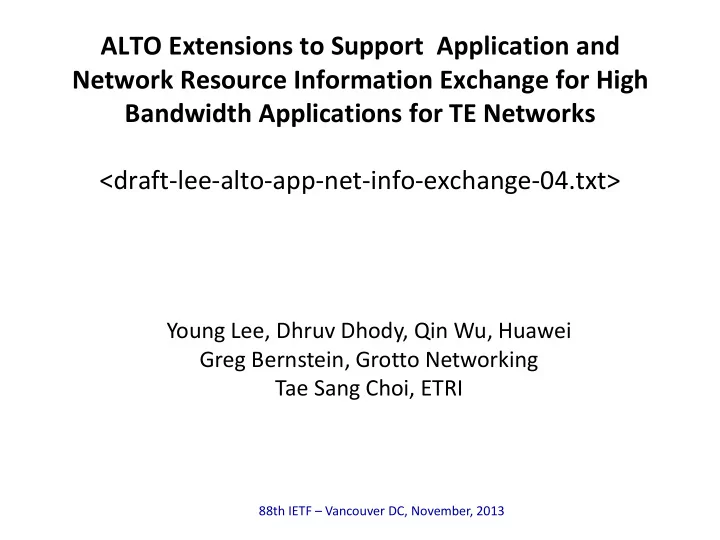

ALTO Extensions to Support Application and Network Resource Information Exchange for High Bandwidth Applications for TE Networks <draft-lee-alto-app-net-info-exchange-04.txt> Young Lee, Dhruv Dhody, Qin Wu, Huawei Greg Bernstein, Grotto Networking Tae Sang Choi, ETRI 88th IETF – Vancouver DC, November, 2013
Scope This draft is to fulfill Large Bandwidth Use Case: <draft-bernstein-alto-large-bandwidth-cases-01> The context is TE networks Introducing new requirements to the current ALTO: • Graph Representation & Multiple Cost • Optimization Criteria • Constraint Filtering on paths or graphs (e.g., bandwidth, latency, hop count, packet loss, etc.) • Multiple Service Class 88th IETF – Vancouver DC, November, 2013
ALTO NET-APP context Application User Orchestrator ALTO Client ALTO Request ALTO Reply ALTO Server Network Topology Orchestrator DB (TED, LSDB) 88th IETF – Vancouver DC, November, 2013
Large Bandwidth Use Case < draft-bernstein-alto-large-bandwidth-cases-01> Case 1: End System Aggregation: Many clients Case 2: Traffic engineered “express lanes” between using services offered at two or more “data data centers and end user regions centers” Client Client “Region B” Client B1 Data Client “Region B” B2 Client B1 Data B2 Client Center 2 B3 Center 2 B3 … Client … Client Client “Region A” A1 Client BN “Region A” A1 BN Client Client A2 A2 Data Client Data Network Client Center 3 A3 Center 3 A3 … … Client Client Client Client AN C1 Client AN C1 Client C2 C2 Client Data Data “Region C” Client C3 “Region C” Center 1 Center C3 … Client … 1 Client CN CN Independent Independent Data Center X Data Center Y Case 3: Data Center to Data Center Communications: Business Application Overlays, Recovery #N DC-b Network Business #1 DC-a Business #N DC-a Business … #1 DC-b Business Business #2 DC-b #2 DC-a 88th IETF – Vancouver DC, November, 2013
ALTO Query Mechanism that filters the request constraints Cost Type:= ‘ routingcost ’ as defined by base specification. Additional cost (ex. latency, hopcount) are defined in [MultiCost] and [TE- cost]. ALTO Cost Mode :={summary, graph} /* the cost map Client can be either a summary form or a graph form */ Constraints /* a set of constraints that apply to ALTO the requested path summary or graph for filtering. (E.g.,, constraints can be like Request bandwidth greater than ‘x’, latency less than ‘y’, hopcount less than ‘z’, packetloss less than ‘a’ etc .) */ Objective-function (or Optimization Criteria): ALTO The summary or the graph should be computed Server based on optimizing which parameter – IGP cost, latency, residual bandwidth, etc. Service-Class:= {gold, silver, bronze} /*the service class as described in this document*/ 88th IETF – Vancouver DC, November, 2013
ALTO Response Mechanism with Reduction of Data Sets The list of feasible Source-Destination pair and its Cost Type : For each feasible S-D ALTO pair, indicate the following: Client • Service Class; • Cost Mode; • Cost Type; ALTO • Endpoint Cost Map Data Response • Parameter Values /* indicate the actual values of each constraint requested */ Note that in case of Graph, each S-D pair is the source of the abstract link and the destination of the abstract link. Change ALTO from constraints to parameters Server 88th IETF – Vancouver DC, November, 2013
Info Model Alto request: Alto response: Object{ Object-map{ TypedEndpointAddr Src<1...*>; /*atleast one JSONString costparam; source*/ } EndpointCostParam ; TypedEndpointAddr Dsts<2...*>; /*atleast two destinations*/ Object-map{ }EndpointList; TypedEndpointAddr -> EndpointCostParam<1...*>; Object{ } EndpointCosts ; ServiceClass service-class; CostMode cost-mode; Object-map{ CostType cost-type; TypedEndpointAddr -> EndpointCosts; [JSONString constraints<0...*>; ] } EndpointCostMapData ; [JSONString ObjectiveFunction] EndpointList endpoints; Object{ }EndpointCostMapReq; ServiceClass service-class; CostMode cost-mode; CostType cost-type; [EndpointCostMapData map;] }EndpointCostMapRsp; 88th IETF – Vancouver DC, November, 2013
Encoding Example Alto Request: POST /endpointcost/lookup HTTP/1.1 Host: alto.example.com Content-Length: [TODO] Content-Type: application/alto-csoendpointcostparams+json Accept: application/alto-csoendpointsummary+json,application/alto- error+json { "service-class" : "silver", "cost-mode" : "summary", "cost-type" : "routingcost", "constraints": ["availbw gt 20", "delay lt 10", "pktloss lt 0.03", "jitter lt 10", "hopcount lt 5" ], "endpoints" : { "srcs": ["ipv4:192.0.2.2", "ipv4:192.0.2.10" ], "dsts": ["ipv4:192.0.2.89", "ipv4:198.51.100.34", "ipv4:203.0.113.45" ] } } 88th IETF – Vancouver DC, November, 2013
Alto Response : HTTP/1.1 200 OK Content-Length: [TODO] Content-Type: application/alto-csoendpointsummary+json { "meta" : {}, "data" : { "service-class" : "silver", "cost-mode" : "summary", "cost-type" : "routingcost", "map" : { "ipv4:192.0.2.2": { "ipv4:192.0.2.89" : [ "delay eq 5", "jitter eq 5", "pktloss eq 0.01", "hopcount eq 8", "cost eq 100" ], "ipv4:198.51.100.34" : [ "delay eq 9", "jitter eq 3", "pktloss eq 0.02", "hopcount eq 10", "cost eq 500" ], "ipv4:203.0.113.45" : [ "delay eq 4", "jitter eq 4", "pktloss eq 0.02", "hopcount eq 12", "cost eq 200" ] } "ipv4:192.0.2.10": { "ipv4:192.0.2.89" : [ "delay eq 4", "jitter eq 4", "pktloss eq 0.03", "hopcount eq 6", "cost eq 300" ], "ipv4:203.0.113.45" : [ "delay eq 6", "jitter eq 6", "pktloss eq 0.04", "hopcount eq 8", "cost eq 400"] } } } } 88th IETF – Vancouver DC, November, 2013
Summary & Next Steps This draft fulfills high-bandwidth TE network exchange using ALTO mechanism introducing: • Graph Representation & Multiple Cost • Optimization Criteria • Constraint Filtering on paths or graphs (e.g., bandwidth, latency, hop count, packet loss, etc.) • Multiple Service Class 88th IETF – Vancouver DC, November, 2013
Recommend
More recommend